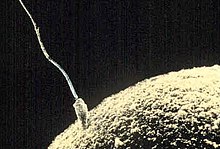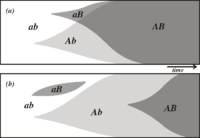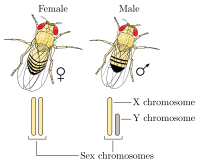This is an old revision of this page, as edited by John Reaves (talk | contribs) at 01:54, 1 April 2008 (Unprotected Sex: is the way to go). The present address (URL) is a permanent link to this revision, which may differ significantly from the current revision.
Revision as of 01:54, 1 April 2008 by John Reaves (talk | contribs) (Unprotected Sex: is the way to go)(diff) ← Previous revision | Latest revision (diff) | Newer revision → (diff)This article is about biological sex. For alternate uses, such as sexual intercourse, see Sex (disambiguation).

In biology, sex is the process of combining and mixing genetic traits, often resulting in the specialization of organisms into male and female reproductive roles. Sexual reproduction involves combining specialized cells (called gametes) to form offspring that inherit traits from both parents. Gametes can be identical in form and function, but in many cases an asymmetry has evolved such that two types of gametes exist: male gametes are small and are optimized to transport their genetic information, while female gametes are large and carry the nutrients necessary for the development of the child organism.
An organism's sex is defined by the gametes it produces: males produce male gametes (sperm) while females produce female gametes (egg cells); organisms which produce both male and female gametes are hermaphrodites. Frequently physical differences are associated with the different sexes of an organism; these sexual dimorphisms can reflect the different reproductive pressures the sexes experience. In some cases female organisms also have the role of carrying offspring through the first part of development, a process called gestation.
Biological sex is distinct from gender. Although these words are commonly used interchangeably, gender refers to an individual's self-conception or social conception as being male or female.
Sexual reproduction
Main article: sexual reproduction
Sexual reproduction is a process where organisms form offspring that combine genetic traits from both parents. Genetic traits are contained within the DNA of chromosomes — by combining a set of chromosomes from each parent, an organism is formed containing a doubled set of chromosomes. This double-chromosome stage is called "diploid", while the single chromosome stage is "haploid". Diploid organisms can, in turn, form haploid cells that randomly inherit one of the two different chromosomes, a process called meiosis. Meiosis also involves a stage of chromosomal crossover, in which regions of DNA are exchanged between the two chromosomes to form a new pair of mixed chromosomes. These processes result in the recombining of different genetic traits.
In many organisms the haploid stage has been reduced to specialized cells called gametes specialized to recombine and form a new diploid organism. The condition of having types of gametes that are externally similar—particularly in size—is called isogamy; having gametes that are somewhat dissimilar is anisogamy. By convention, the larger gamete cell (called an egg cell or ovum) is considered female, while the smaller gamete (called a sperm) is considered male. An individual that produces exclusively large gametes is said to be female, and one that produces exclusively small gametes is said to be male. An individual that produces both types of gametes is called hermaphrodite.

Evolution
Main article: Evolution of sexFossil records indicate that sexual reproduction has been occurring for at least one billion years. However, the reason for the initial evolution of sex, and the reason it has survived to the present are still matters of debate. Some of the many plausible theories include: that sex creates variation among offspring, sex helps in the spread of advantageous traits, and that sex helps in the removal of disadvantageous traits.
Sexual reproduction is a process specific to eukaryotes, organisms whose cells contain a nucleus and mitochondria. In addition to animals, plants, and fungi, other eukaryotes (eg. the malaria parasite) also engage in sexual reproduction. Some bacteria have use conjugation to transfer genetic material between bacteria; while not the same as sexual reproduction, this also results in the mixture of genetic traits.
What is considered defining of sexual reproduction is the difference between the gametes and the binary nature of fertilization. Multiplicity of gamete types within a species would still be considered a form of sexual reproduction. However, of more than 1.5 million living species, recorded up to about the year 2000, "no third sex cell — and so no third sex — has appeared in multicellular animals."
Animals

Sexually reproducing animals spend their lives as diploid organisms, with the haploid stage reduced to single cell gametes. The gametes of animals have male and female forms—spermatozoa and egg cells. These gametes combine to form embryos which develop into a new organism.
The male gamete, a spermatozoan, is a small cell containing a single long flagella which propels it. Spermatozoa are extremely reduced cells, lacking many cellular components that would be necessary for embryonic development. They are specialized for motility, seeking out an egg cell and fusing with it in a process called fertilization.
Female gametes are egg cells, large immobile cells that contain the nutrients and cellular components necessary for a developing embryo. Egg cells are often associated with other cells which support the development of the embryo, forming an egg. In mammals, the fertilized embryo instead develops within the female, receiving nutrition directly from its mother.
Animals are usually mobile and seek out a partner of the opposite sex for mating. Animals which live in the water can mate using external fertilization, where the eggs and sperm are released into and combine within the surrounding water. Most animals that live outside of water, however, must use sexual intercourse to bring gametes together. This typically involves the male inserting a sexual organ into the female's reproductive tract to achieve insemination and subsequent fertilization.

Plants
Main article: Plant sexualityLike animals, plants have developed specialized male and female gametes. Within most familiar plants, male gametes are contained within hard coats, forming pollen. The female gametes of plants are egg cells; once fertilized by pollen these form seeds which, like eggs, contain the nutrients necessary for the development of the embryonic plant. Flowers are the sexual organs of flowering plants, producing both pollen and eggs.
Because plants are immobile, they depend upon passive methods for transporting pollen grains to other plants. Many plants, including most conifers, produce lightweight pollen which is carried by wind to neighboring plants. Other plants have heavier, sticky pollen that is specialized for transportation by insects. The plants attract these insects with nectar-containing flowers—the sexual organs of flowering plants. Insects transport the pollen as they move to other flowers, which also contain female reproductive organs, resulting in pollination.

Fungi
Main article: Mating in fungiMost fungi reproduce sexually, having both a haploid and diploid stage in their life cycles. These fungi are typically isogamous, lacking male and female specialization: haploid fungi grow into contact with each other and then fuse their cells. In some of these cases the fusion is asymmetric, and the cell which donates only a nucleus (and not accompanying cellular material) could arguably be considered "male".
Some fungi, including baker's yeast, have mating types that create a duality similar to male and female roles. Yeast with the same mating type will not fuse with each other to form diploid cells, only with yeast carrying the other mating type.
Fungi produce mushrooms as part of their sexual reproduction. Within the mushroom diploid cells are formed, later dividing into haploid spores—the height of the mushroom aids the dispersal of these sexually produced offspring.
Sex determination
Main article: sex determinationThere are three sexes organisms can have: male, female, and hermaphrodite. The most basic sexual system is one in which all organisms are hermaphrodites, producing both male and female gametes—this is true of some animals (eg. snails) and the majority of flowering plants. In several cases, however, specialization of sex has evolved such that organisms produce only male or female gametes. The biological cause for an organism developing into one sex or the other is called sex determination. Sometimes an organism's development is intermediate between male and female, a condition called intersex; unlike biological hermaphrodites, intersex individuals are not fertile in both male and female aspects.
Genetic

In genetic sex determination systems, an organism's sex is determined by the genome it inherits. Genetic sex determines usually depends on asymmetrically inherited sex chromosomes which carry genetic features that influence development; sex may be determined either by the presence of a sex chromosome or by how many the organism has. Sex determination based on sex chromosomes, because it is determined by chromosome assortment, results in 1:1 ratio of male and female offspring.
Humans and other mammals have an XY sex determination system: the Y chromosome carries factors responsible for triggering male development. The default sex, in the absence of a Y chromosome, is female. Thus, XX mammals are female, and XY are male. XY sex determination is found in other organisms, including the common fruit fly and some plants. In some cases, including in the fruit fly, it is the number of X chromosomes that determines sex rather than the presence of a Y chromosome.
In birds, which have a ZW sex-determination system, the opposite is true: the W chromosome carries factors responsible for female development, and default development is male. In this case ZZ individuals are male, and ZW are female. The majority of butterflies and moths also have a ZW sex-determination system. In both XY and ZW sex determination systems the sex chromosome carrying the critical factors is often significantly smaller, carrying little more than the genes necessary for triggering the development of a given sex.
Many insects use a sex determination system based on the number of sex chromosomes. This is called XX/XO sex determination—the O indicates the absence of the sex chromosome. All other chromosomes in these organisms are diploid, but organisms may inherit one or two X chromosomes. In field crickets, for example, insects with a single X chromosome develop as male, while those with two develop as female.
Other insects, including bees and ants, use a haplodiploid sex-determination system. In this case diploid individuals are female, and haploid individuals (which develop from unfertilized eggs) are male. This sex-determination system results in highly biased sex ratios, as the sex of offspring is determined by fertilization rather than the assortment of chromosomes during meiosis.

Nongenetic
For many species sex is not determined by inherited traits, but instead by environmental factors experienced during development or later in life. Many reptiles have temperature-dependent sex determination: the temperature embryos experience during their development determines the sex of the organism. In some turtles, for example, males are produced at lower incubation temperatures than females; this difference in critical temperatures can be as little as 1-2°C.
Many fish change sex over the course of their lifespan, a phenomenon called sequential hermaphroditism. In clownfish, smaller fish are male, and the dominant and largest fish in a group becomes female. In many wrasses the opposite is true—most fish are initially female and become male when they reach a certain size. Sequential hermaphrodites may produce both types of gametes over the course of their lifetime, but at any given point they are either female or male.
In some ferns the default sex is hermaphrodite, but ferns which grow in soil that has previously supported hermaphrodites are influenced by residual hormones to instead develop as male.
Sexual dimorphism

Many animals have differences between the male and female sexes in size and appearance, a phenomenon called sexual dimorphism. Sexual dimorphisms are often associated with sexual competition - antlers in male deer, for example, are used in combat between males to win reproductive access to female deer. In many cases the male of a species is larger in size; in mammals species with high sexual size dimorphism tend to have highly polygynous mating systems—presumably due to selection for success in competition with other males.
Other animals, including most insects and many fish, have larger females. In some cases this may be associated with the cost of producing egg cells, which require more nutrition than the production of small sperm cells. Occasionally this dimorphism is extreme, with males reduced to living as parasites dependent on the female.
In birds, males often have a more colorful appearance and may have features (like the long tail of male peacocks) that would seem to put the organism at a disadvantage (eg. bright colors would seem to make a bird more visible to predators). One proposed explanation for this is the handicap principle. This hypothesis says that, by demonstrating he can survive with such handicaps, the male is advertising his genetic fitness to females—traits that will benefit daughters as well, who will not be encumbered with such handicaps.
Sex differences in humans include a larger size and more body hair in men; women have breasts, wider hips, and a higher body fat percentage.
References
- Leslie E. Orgel, 'The Origin of Life on the Earth', Scientific American October, 1994.
- 'RedList', International Union for the Conservation of Nature and Natural Resources official website.
- Amanda Schaffer, Pas de Deux: Why Are There Only Two Sexes?, Slate updated 27 September, 2007.
- Laurence D. Hurst, 'Why are There Only Two Sexes?', Proceedings: Biological Sciences 263 (1996): 415-422
- ES Haag, 'Why two sexes? Sex determination in multicellular organisms and protistan mating types', Seminars in Cell and Developmental Biology 18 (2007): 348-9.
- Dellaporta SL, Calderon-Urrea A (1993). "Sex Determination in Flowering Plants". The Plant Cell. 5: 1241–1251.
- Tanurdzic M and Banks JA (2004). "Sex-Determining Mechanisms in Land Plants". The Plant Cell. 16: S61 – S71.
External links and further reading
- Francoeur, Robert T. (ed.), The International Encyclopedia of Sexuality
- Janssen, D. F., Growing Up Sexually. Volume I. World Reference Atlas
- Francoeur, Robert T. and Rayond J. Noonan, (eds.) "Continuum Complete International Encyclopedia of Sexuality". Continuum, August 2003, ISBN 0-8264-1488-5
- Human Sexual Differentiation by P. C. Sizonenko
- New Scientist article on Sex chromosomes in the platypus
- Human Sexuality Info by University of California Santa Barbara